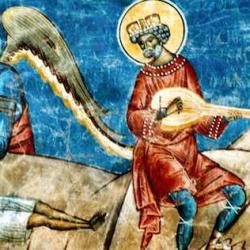“Touch not my anointed, and do my prophets no harm.” That is how Psalm 105:15 summarizes the Lord’s care of the patriarchs who were wanderers and strangers in the earth. “He permitted no many to oppress them, and he reproved kings for their sake” (v. 14, alluding to Genesis 12 and 20).
Many of the “touch not” restrictions in the Torah apply not to persons but to objects. When Moses sets up the tabernacle, he anoints the altar of ascensions, the tabernacle, and the laver, as well as the priests (Exodus 40). The furnishings of the tabernacle became consecrated objections, and to touch them was an infringement on the holiness of the tabernacle. To touch a holy thing was an act of sacrilege.
The parallel between holy things and sanctified persons runs through the Old Testament. When Nebuchadnezzar takes the holy people into exile, he also takes the vessels of the temple. Yahweh expects him to respect both (“touch not my anointed!”). When Belshazzar brings out the temple vessels, he pays the price, losing his kingdom (Daniel 5).
This implies that the tabernacle system is a not only a liturgical pedagogy, but a political and social one. Refraining from touching the holy things of Yahweh trained Israel in habits of reverence for Yahweh, the Holy One of Israel. And those habits were to spread out into social and political life. When David refused to lay a hand on the anointed King Saul, he was applying a principle he learned from the sanctuary.
Ultimately, Israel did touch the anointed, the Christ, Jesus. Jesus’ crucifixion was a judicial murder. It was also sacrilege. But out of this climactic sacrilege, the Lord has brought the sanctification of the world. Untying that knot would get us to the heart of the mystery of the atonement.















